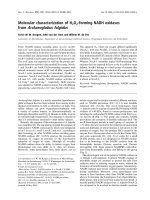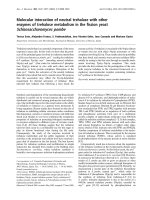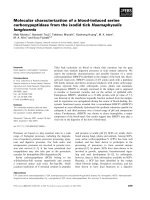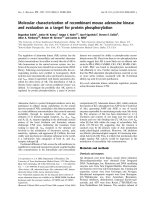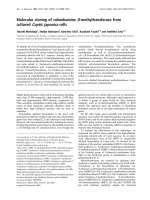Báo cáo y học: " Molecular characterization of porcine circovirus 2 isolated from diseased pigs co-infected with porcine reproductive and respiratory syndrome virus" pot
Bạn đang xem bản rút gọn của tài liệu. Xem và tải ngay bản đầy đủ của tài liệu tại đây (295.34 KB, 4 trang )
STUDY PROTO C O L Open Access
Molecular characterization of porcine circovirus 2
isolated from diseased pigs co-infected with
porcine reproductive and respiratory syndrome
virus
Jianzhong Yi
*
, Chengqian Liu
Abstract
In this study, we isolated a porcine circovirus 2 (PCV2) strain from piglets co-infected with porcine reproductive
and respiratory syndrome virus (PRRSV). The complete genome of this strain was sequenced, phylogenetic and
polymorphic analyses were carried out. BLAST searches revealed the highest sequence identity (99.5% nt and
99.3% aa) to Guangxi strain EF675230. The phylogenetic tree showed that clustering of the isolates didn’t strongly
correlate to geographical distribution. Polymorphic analyses demonstrated that the amino acids at most of the
polymorphic sites in Open Reading Frame 1(ORF1) and 2 (ORF2)belong to the same amino acid group according
to chemical or structural properties, and revealed that highly polymorphic regions overlapped with the known
immunoreactive epitopes of ORF2.
1 Introduction
Postweaning multisystemic wasting syndrome (PMWS),
characterized by growth reta rdation, paleness of the skin,
dyspnea, and increased mortality rates [1,2], was first
described in Canada in 1991, and is now widespread
throughout swine p roduction areas of the world [3,4].
The genome of PCV is a single-stranded circular DNA of
about 1.76 kb. ORF1 encodes the Rep proteins involved
in virus replication and is highly conserved among iso-
lates [5]. ORF2 encodes a 234 amino acid (aa) Cap pro-
tein, which is the main structural protein and also the
major antigen inducing neutralizing immune responses
[6]. The ORF3 p rotein is involved in PCV2- induced
apoptosis by the caspase-8 and caspase-3 pathways [7].
However, healthy pigs experimentally inoculated with
PCV2 developed only mild clinical symptoms [8,9], sug-
gesting that other concomitant factors may be needed for
the development of typical clinical PMWS [10,11].
Experimental studies on co-infection with PRRSV and
PCV2 resulted in the microscopic lesions associated with
PMWS and/or porcine dermatitis and nephropathy
syndrome (PDNS), and lead to the development of severe
disease [12].
In may 2008, severe disease, known as “high fever’’
occurred in several pig farms in shanghai, leading to a
57% death rate. PRRSV was detected in all the diseased
piglets, genome sequence blast showed the strain
belongs to genotype 2 , 99.4% homologous to the PRRS
virus strain JXA1 isolated in China, which has been
proved to cause porcine high fever disease with high
morbidity and m ortality[13]. There was no Porcine Par-
vovirus (PPV) detected in all the samples, but we
detected PCV2 from all the PRRS infected piglet s (Fig-
ure 1). To investigate the genetic relationship of this
newly identified Shanghai PCV2 isolate with existing
viruses isolated fro m other parts of the world, we
sequenced the complete genome of the sh0901 s train
and carried out phylogenetic and polymorphic analyses.
2. Materials and methods
2.1 Primer design and synthesis
Two pairs of primers were designed according to the pub-
lished PCV2 genome sequence of strain AY691679, using
the Primer 5.0 software. The sequences of the primers
* Correspondence:
Institute of Animal Husbandry Veterinary Sciences, Shanghai Academy of
Agricultural Sciences, 2901 Beidi Road, Shanghai 201106, PR China
Yi and Liu Virology Journal 2010, 7:286
/>© 2010 Yi and Li u; licensee BioMed Central Ltd. This is an Open Access article distributed under the terms of the Creative Commons
Attribution License ( s/by/2.0), which permits unrestricted use, distribution, and rep roduction in
any medium, provided the original work is properly cited.
were as follows: upper primers , F1- 5′ -AGAATTCAA
CCTTAACCTTTCT-3′ and F2- 5′-AATCCTTCCGAA-
GACGAGCGCA-3′; reverse primers, R1- 5′-AGAATTCT
GGCCCTGCTCC-3′ and R2- 5′ -TGGGCTCCACTGC
TGTTATTC-3’. Primers were synthesized by the Shanghai
Sangon Biological Engineering Technology & Services Co.
Ltd. (Shanghai, PR China).
2.2 DNA extraction
Five homogenized Lung samples were collected from
deceased pigs, DNA was extracted using a DNA mini
kit (Tiangen Inc., PR China) according to the manufac-
turer’s instructions.
2.3 Whole genome amplification
The thermocycling conditions were: 3 min at 94°C, then
35 cycles consisting of 30 s at 94°C, 35 s at 60°C and
2 min at 72°C, with a final extension at 72°C for 10 min.
The PCR products were subjected to 1% (w/v) agarose
gel electrophoresis, and visualized by ethidium bromide
staining under UV illumination. Five PCR products were
then subjected to DNA sequencing by the Shanghai
Generay Biotech Co. Ltd. (Shanghai, PR C hina) with the
same primers used for PCR.
2.4 Phylogenetic analysis of ORF2
Sequence comparisons were made by aligning the
sequence of the virus isolate with those of other isolates
using the algorithm CLUSTALW (version 1.8) method
in the program MEGALIGN (DNASTAR, Lasergene
version 7) at both the nucleotide (nt) and deduced aa
levels. To analyze the homology and evolutionary relat-
edness, prototype genes for PCV2 were obtained from
GenBank at the National Center for Biotechnology
Information, USA (). Phylo-
genetic analyses were conducted using MEGA version
4.0 and elaborated with both parsimony and distance
methods, supplying statistical support with bootstrap-
ping over 1000 replicates.
3. Results
3.1 Genome sequence of the isolated strain
PCR amplification showed the five diseased pigs co-
infected with PCV2 and PRRSV (Figure 1). The genome
of the isolated viruses was 1767 nucleotide (nt) in
length. The genome sequence was assembled, aligned
using Seqman software (DNASTAR, Lasergene version
7), submitted to GenBank and assigned the accession
number, GU124593. The genome se quence was con-
firmed to be PCV2 by BLAST searches against the Gen-
Bank database.
3.2 Sequence and phylogenetic analysis of ORF2
The ORF2 DNA sequence of the virus isolate shared
99.4% nt identity with the Guangxi isolate (accession
number EF675230) and 94.0% with the Jiangsu isolate
(accession number AY691679). The results indicated
that the ORF2 sequence was not distinct in different
geographical areas.
To determine the evolutionary relatedness of the new
isolate, the ORF2 gene sequence was aligned with
selecte d PCV2 isolates acquired from GenBank and per-
formed phylogenetic analysis. The data showed that the
virus isolate was classified into group 1 clust er C with
the Guangxi strain (Figure 2).
3.3 Polymorphic analysis of ORF1, ORF2, and ORF3
Sequence alignment of the 46 geographically distinct
PCV2 isolates revealed four polymorphic aa sites within
ORF1 (Table 1). The aa at positions 35 are acidic resi-
dues, the aa at positions 77 and 105 belong to the group
of nonpolar aa, while the aa at position 121 belong to
the polar, uncharged group. Among the 22 polymorphic
sites in ORF2, ther e were two aa d ifferences at 16 sites,
among which ea ch pair of aa at the 12 sites belonged to
the same amino acids group according to their chemical
structure. There are six polymorphic sites in ORF3, the
amino acids at the polymor phic sites belong to diff erent
aa groups, except the aa at position 100, indicated high
divergence in the chemical and structural properties of
the aa of ORF3 in different PCV2 strains.
4. Discussion
In the present study, the diseased piglets were infected
with PRRSV and PCV2 viruses, detected by PCR and RT-
PCR amplification, therefore, the levels of expo sure to
the infectious agents were theoretically identical for all
Figure 1 Dection of PCV2 and PRRSV in five diseased pigs.
Blood samples from five diseased pigs were collected, viruses DNA
and RNA were purified, respectively. After RT-PCR and PCR
amplification, the amplified products run 1% agrose gel.
Yi and Liu Virology Journal 2010, 7:286
/>Page 2 of 4
animals. The severe lesions and c linical symptoms indi-
cated that PRRSV could be a predisposing factor to the
high mortality, as previously suggested [14]. Several
hypothesis have been suggested to explain this epidemio-
logical situation, PRRSV may interfere with PCV2 clear-
ance, fa vor the persistence of the virus. Howev er, the
nature of the interaction between PRRSV and PCV2 has
not been elucidated to date. The ORF2 protein has been
considered as a major immunogenic capsid protein, able
to stimulate a protective response in pigs. Five immunor-
eactive epitopes in ORF2 were identified by Mahe’ et al
using Pepscan analysis[15], these included residues 25-
43, 65-87, 113-147,157-183 and 193-207. Larochelle et al
(2002) also identified three major regions of aa heter oge-
neity among ORF2 sequences at residues 59-80, 121-136
and180-191,andtwooftheseregions corresponded to
two of the immunoreactive e pitopes demonstrated by
Mahe’ et al [16]. In this study, we identified six highly
polymorphic regions, 26-50, 57-83, 90-120, 134-154, 169-
191 and 206-215, by polymorphic analysis, overlapped
with corresponded immunoreactive epitopes, thus
demonstrated that polymorphic analysis could be ap plied
Figure 2 Phylogenetic tree of the ORF2 gene of PCV2 strains.
Yi and Liu Virology Journal 2010, 7:286
/>Page 3 of 4
to deduce the immunoreactive epitopes of viruses. Our
analysis show that ORF1 is highly conserved with on ly
four polymorphic sites, and the amino acids at each of the
sites belong to the same groups regarding chemical struc-
ture, which indicate that these mutations have no big
influence on the activity of the Rep protein. Polymorphic
sites were clustered in the capsid protein, and overlapped
with the immunoreactive epitopes, So ORF2 may play a
major role in the varied pathogenicity of PCV2 isolates.
Acknowledgements
This research was supported by research funds from the Shanghai Pujiang
Program, project no. 07pj14074 and Technology Commission of Shanghai
Municipality(Project No.2 007-11-1).
Authors’ contributions
JZ carried out the molecular genetic studies, participated in the sequence
alignment and drafted the manuscript. CQ carried out the immunoassays
and participated in the sequence alignment. JZ participated in the design of
the study and performed the statistical analysis. All authors read and
approved the final manuscript.
Competing interests
The authors declare that they have no competing interests.
Received: 13 September 2010 Accepted: 27 October 2010
Published: 27 October 2010
References
1. Tischer I, Glederblom H, Vettermann W, Koch MA: A very small porcine
virus with circular single-stranded DNA. Nature 1982, 295:64-66.
2. Harding JCS, Clark EG: Recognizing and diagnosing postweaning
multisystemic wasting syndrome (PMWS). J Swine Health Prod 1997,
5:201-203.
3. Allan GM, McNeilly F, Kennedy S, Daft B, Clarke EG, Ellis JA, Haines DM,
Meehan BM, Adair BM: Isolation of porcine circovirus-like viruses from
pigs with a wasting disease in the USA and Europe. J Vet Diagn Invest
1998, 10:3-10.
4. Ellis J, Krakowka S, Lairmore M, Haines D, Bratanich A, Clark E, Allan G,
Konoby C, Hassard L, Meehan B, Martin K, Harding J, Kennedy S, McNeilly F:
Reproduction of lesions of postweaning multisystemic wasting
syndrome in gnotobiotic piglets. J Vet Diagn Investig 1999, 11:3-14.
5. Harms PA, Sorden SD, Halbur PG, Bolin SR, Lager KM, Morozov I, Paul PS:
Experimental reproduction of severe disease in CD/CD pigs concurrently
infected with type 2 porcine circovirus and porcine reproductive and
respiratory syndrome virus. Vet Pathol 2001, 38:528-539.
6. Olvera A, Cortey M, Segalés J: Molecular evolution of porcine circovirus
type 2 genomes: phylogeny and clonality. Virology 2007, 357(2):175-85.
7. Liu J, Chen I, Kwang J: Characterization of a previously unidentified viral
protein in porcine circovirus type 2-infected cells and its role in virus-
induced apoptosis. J Virol 2005, 79:8262-8274.
8. Rosell C, Segale’s J, Ramos-Vara JA, Folch JM, Rodrı’guez-Arrioja GM,
Duran CO, Balasch M, Plana-Dura’n J, Domingo M: Identification of porcine
circovirus in tissues of pigs with porcine dermatitis and nephropathy
syndrome. Vet Rec 2000, 146:40-43.
9. Mankertz A, Mankertz J, Wolf K, Buhk H-J: Identification of a protein
essential for replication o f porcine circovirus. J Gen Virol 1998, 79:381-384.
10. Cheung AK: Comparative analysis of the transcriptional patterns of
pathogenic and nonpathogenic porcine circoviruses. Virology 2003,
310:41-49.
11. Choi J, Stevenson GW, Kiupel M, Harrach B, Anothayanontha L, Kanitz CL,
Mittal SK: Sequence analysis of old and new strains of porcine circovirus
associated with congenital tremors in pigs and their comparison with
strains involved with postweaning multisystemic wasting syndrome. Can
J Vet Res 2002, 66:217-224.
12. Rovira A, Balasch M, Segale’s J, Garcı’a L, Plana-Dura’ n J, Rosell C,
Ellerbrok H, Mankertz A, Domingo M: Experimental inoculation of
conventional pigs with porcine reproductive and respiratory syndrome
virus and porcine circovirus 2. J Virol 2002, 76
:3232-3239.
13. Tian K, Yu Y, Zhao T, et al: Emergence of fatal PRRSV variants:
Unparalleled outbreaks of atypical PRRS in china and molecular
dissection of the unique hallmark. PLoS ONE 2007, 6:e526.
14. Allan GM, Kennedy S, McNeilly F, Foster JC, Ellis JA, Krakowka SJ,
Meehan BM, Adair BM: Experimental reproduction of severe wasting
disease by co-infection of pigs with porcine circovirus and porcine
parvovirus. J Comp Pathol 1999, 121:1-11.
15. Mahe’ D, Blanchard P, Truong C, Arnauld C, Le Cann P, Cariolet R, Madec F,
Albina E, Jestin A: Differential recognition of ORF2 protein from type 1
and type 2 porcine circoviruses and identification of immunorelevant
epitopes. J GenVirol 2000, 81:1815-1824.
16. Larochelle R, Magar R, D’Allaire S: Genetic characterization and
phylogenetic analysis of porcine circovirus type 2 (PCV2) strains from
cases presenting various clinical conditions. Virus Res 2002, 90:101-11.
doi:10.1186/1743-422X-7-286
Cite this article as: Yi and Liu: Molecular characterization of porcine
circovirus 2 isolated from diseased pigs co-infected with porcine
reproductive and respiratory syndrome virus. Virology Journal 2010 7:286.
Table 1 The distribution of amino acids at polymorphic
sites in ORF1, ORF2, and ORF3, from 45 PCV2 strains
Amino acid
position
The distribution of amino acids
at the polymorphic sites
ORF1 33 8 D 37 E
77 23 F 22 L
105 18M 27 I
121 4 S 41T
ORF2 2 14 F 31Y
30 39V 6 L
53 39F 6I
57 34V 12 I
59 15R 7K 23A
63 25R 11K 5S 4T
75 39N 6 K
76 40I 5L
77 37N 8D
87 8 T 37 S
89 31P 14K
90 13R 13I 19L
91 22T 13S
92 23V 12I
134 9N 36T
151 28T 17P
169 10R 33S 2G
190 19T 14S 12A
191 5R 13A 27 G
206 30I 15K
210 13E 14D
215 8I 37V
ORF3 29 34T 11A
40 12 R 10S 23G
88 41Q 4E
100 25F 20L
101 9Y 9N 6D 21H
102 32Q 13K
Yi and Liu Virology Journal 2010, 7:286
/>Page 4 of 4




